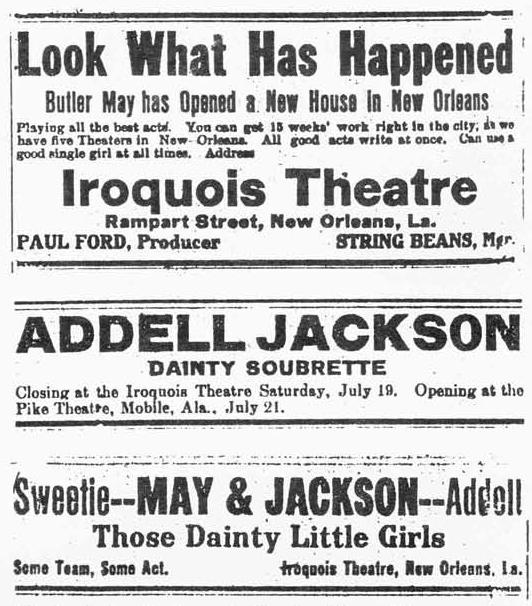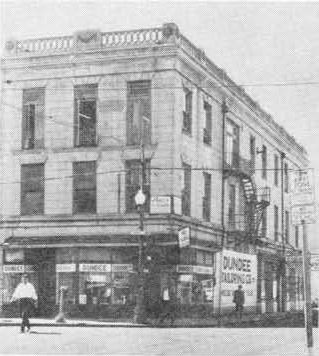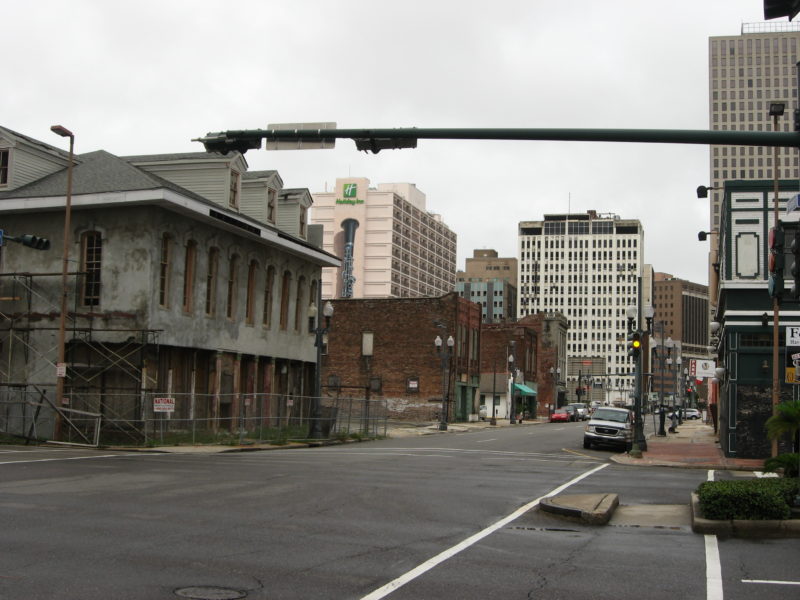The 400 block of South Rampart Street in New Orleans is one of the most historically significant jazz sites in the United States (Eggler, Bruce. “South Rampart Street Demolition Strikes Ominous Chord With Jazz Historians.” The Times Picayune, March 16, 2010). The block, in close proximity to the homes of many significant early jazz musicians, featured a lively and robust jazz scene (Rose, Al. “South Rampart Street.” The Jazz Archivist, Vol. III, Nos. 1-2 (1988): 13-14). The music venues and clubs that once populated South Rampart Street were frequented by the pioneers of jazz as they began to bring their unique brand of music to the world. These music venues and clubs included The Eagle Saloon, which contained the Old Fellows Ballroom and was a favorite haunt of early jazz musicians; The Iroquois Theater, a popular a vaudeville theater; and the Karnofsky Tailor Shop and Residence, home to the Karnofsky family, a Jewish family who played a significant role in the life of famed jazz musician Louis Armstrong.
Landmarks

Block of ads for the Iroquois Theater from the Freeman Paper, Summer 1913 appearing in Abbott, Lynn and Stewart, Jack. “The Iroquois Theater.” The Jazz Archivist, Vol. IX, 2 (1994): 1-20.
It has been argued that the jazz genre first originated from the proliferation of African American vaudeville houses (Walker, Dave. “Bruce Boyd Raeburn Explains Jazz-Landmark Preservation.” The Times Picayune, October 21, 2012). The Iroquois Theater, South Rampart Street’s first vaudeville house, hosted such musicians as Louis Armstrong and Clarence Williams, among other early jazz musicians (Abbott, Lynn and Stewart, Jack. “The Iroquois Theater.” The Jazz Archivist, Vol. IX, 2 (1994): 1-20). In fact, Louis Armstrong won a talent show at the Iroquois Theater dressed in white face. In 1993, the National Park Service Jazz Advisory Commission awarded the Iroquois its highest recommendation as a landmark worth preserving.

The Eagle Saloon Building, as it looked in 1961. Photo by William Russell appearing in Rose, Al.
The Eagle Saloon has also been acknowledged as an historical site. It was added to the U.S. Register of Historical Places in 2009 (Mowbray, Rebecca. “All that’s left of New Orleans’ Historic Jazz Infrastructure: 3 Moldering Buildings on South Rampart Street.” The Times Picayune, May 8, 2011). Buddy Bolden, one of jazz’s earliest musicians, famously played at the Eagle Saloon, as well as John Robichaux, who performed at the Old Fellows Hall on the third floor of the building (Walker).
Musicians
Louis Armstrong grew up just a few blocks away from South Rampart Street. As a boy, he did odd jobs for the Karnofsky family, Lithuanian-Jewish immigrants who lived on South Rampart Street and ran a tailor shop. The family nurtured Armstrong, treating him as a member of the family and giving him the money to buy his first coronet (Mizel, Ann. “Local Dentist Recalls Long Relationship with Matzah-Loving Jazz Musician.” J Weekly, September 16, 2010). Armstrong acknowledged this important relationship when he wrote a memoir on the subject titled Louis Armstrong + the Jewish Family in New Orleans, La., the Year of 1907. In it, he described discovering that this family was also subject to discrimination, and identified with their struggle. As a token of his support, Armstrong wore a Star of David pendant for the rest of his life, describing it as a reminder of “how to livereal life and determination” (Walker).
Patrons
While the New Orleans of the early twentieth century was very culturally diverse (the vestiges of French and Spanish colonial influence still remained, and there was a very strong African American presence along with an influx of immigrants from Europe), the crowd on South Rampart Street generally was not. It was largely an African American community, and Al Rose notes that “if a white man turned up, he was assumed to be an octoroon capable of ‘passing’” (Teachout, Terry. “Satchmo and the Jews.” Commentary Magazine, November, 2009). However, this is not to say that the crowd was not a cultured one. Men were often seen wearing tuxedos, and according to Paul Ford, the manager of the Iroquois Theater, the patrons of his theater also “are in the habit of going to all of the white [theater] houses in the city” (Rose). It is likely that the diverse nature of the city of New Orleans enriched the jazz genre, as the proximity and general awareness of other genres of music and musical theater were clearly important to its early enthusiasts.
Musical Heritage Preservation

Intersection of Poydras and Rampart Street, New Orleans, Louisiana as it stands today. Photo by Ken Lund via Flickr.
The neglect from city government and the limited investment and poor care that owners put into their maintenance and restoration has left little evidence of the once great jazz district. While there are some areas of New Orleans, such as the New Orleans Jazz Historical Park and Congo Square, that have received preservation funding, South Rampart Street has lagged woefully behind. The 400 block of South Rampart Street is now filled with parking lots, marked by graffiti and exposed to the elements (Mowbray). Recently, it has become the focus of fundraising by the New Orleans Jazz Restoration Society.







